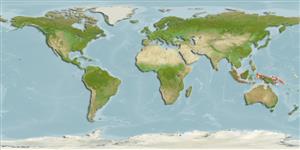Common names from other countries
>
Gobiiformes (Gobies) >
Oxudercidae (Mudskippers) > Periophthalminae
Etymology: Periophthalmus: Greek, peri = around + Greek, ophthalmos = eye (Ref. 45335).
More on author: Bleeker.
Environment: milieu / climate zone / depth range / distribution range
Ecologia
marinhas; estuarina demersal. Tropical
Eastern Indian Ocean: eastern India to Indonesia.
Tamanho / Peso / Idade
Maturity: Lm ? range ? - ? cm
Max length : 12.9 cm SL macho/indeterminado; (Ref. 7050)
Descrição suscinta
Chaves de identificação | Morfologia | Morfometria
Distinguished by the following: joint ventral fins; ventral fins situated directly behind pectoral fins; pelvis connected with shoulder girdle (Ref. 92840); pelvic fins totally united into a rounded
disk; Dl tall, its margin straight, no stripes or spots on fin, first two spines elongate in males, only first spine elongate in females, first spine in males relatively longer than first spine in females; D2 with dusky stripe mesially; dorsal fins not connected by membrane; Dl with 7-10 spines; longitudinal scale count 64-77; head width 12.6-2l.8% SL; pelvic fin length 12.4-16.8% SL; length of anal fin base 16.7-20.6% SL; length of D2 base 16.3-24.3% SL; total D2 elements 12-13; total anal fin elements 11-13; TRDB 15-19 (Ref. 5218).
Facultative air-breathing (Ref. 126274); An intertidal and amphibious air-breather (Ref. 31184) found in brackish mangrove and nipa palm areas (Ref. 7050). Actively shuttling back and forth between rock pools and air (Ref. 31184).
Ciclo de vida ou comportamento de acasalamento
Maturities | Reprodução | Spawnings | Egg(s) | Fecundities | Larvas
Kottelat, M., A.J. Whitten, S.N. Kartikasari and S. Wirjoatmodjo, 1993. Freshwater fishes of Western Indonesia and Sulawesi. Periplus Editions, Hong Kong. 221 p. (Ref. 7050)
Status na Lista Vermelha da UICN (Ref. 130435)
CITES (Ref. 128078)
Not Evaluated
Ameaça para os humanos
Harmless
Uso pelos humanos
Pescarias: sem interesse
Ferramentas
Relatórios especiais
Baixar XML
Fontes da internet
Estimates based on models
Preferred temperature (Ref.
115969): 28.1 - 29.3, mean 28.9 (based on 740 cells).
Índice de diversidade filogenética (Ref.
82804): PD
50 = 0.5000 [Uniqueness, from 0.5 = low to 2.0 = high].
Bayesian length-weight: a=0.00871 (0.00504 - 0.01504), b=2.86 (2.71 - 3.01), in cm Total Length, based on LWR estimates for this species & Genus-body shape (Ref.
93245).
Nível Trófico (Ref.
69278): 3.3 ±0.4 se; based on size and trophs of closest relatives
Resiliência (Ref.
120179): Elevada, tempo mínimo de duplicação da população menor que 15 meses (Preliminary K or Fecundity.).
Fishing Vulnerability (Ref.
59153): Low vulnerability (10 of 100).
